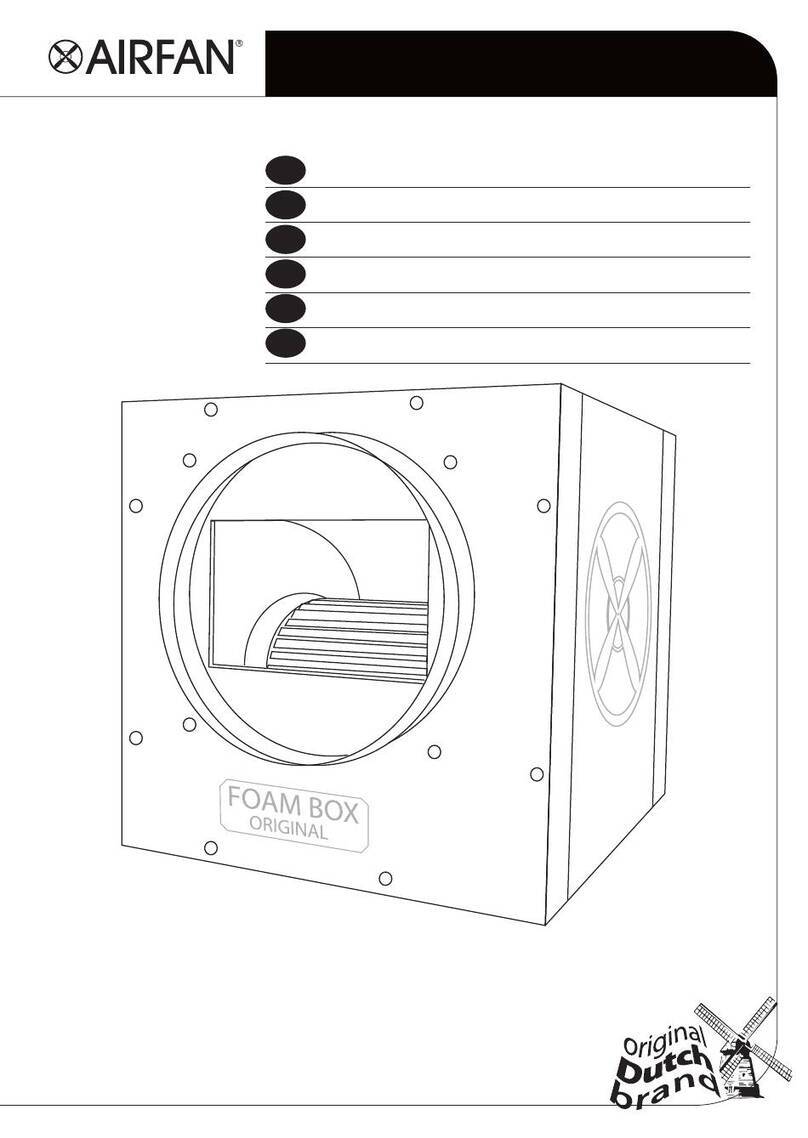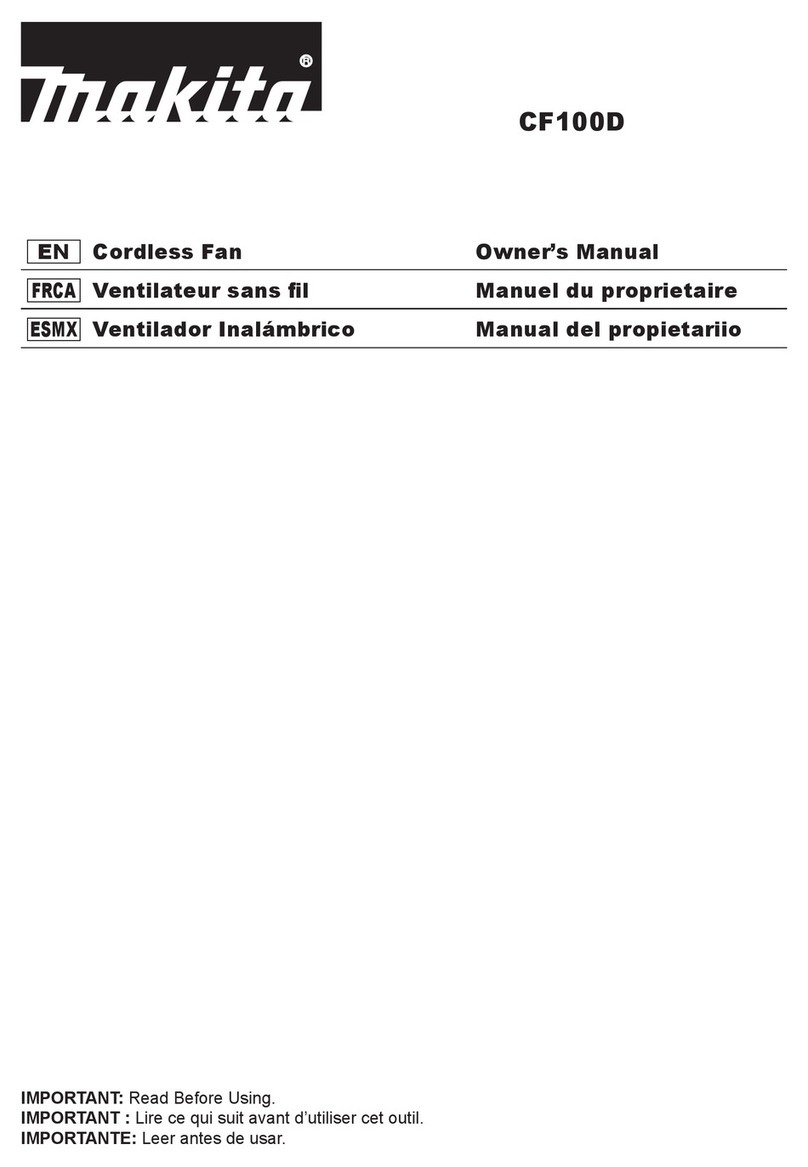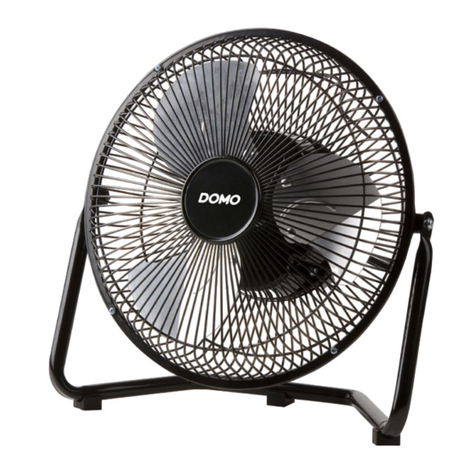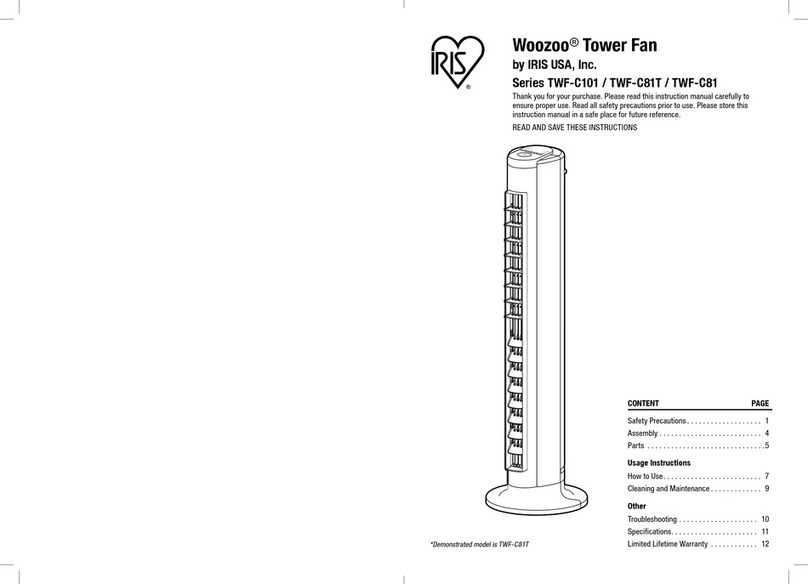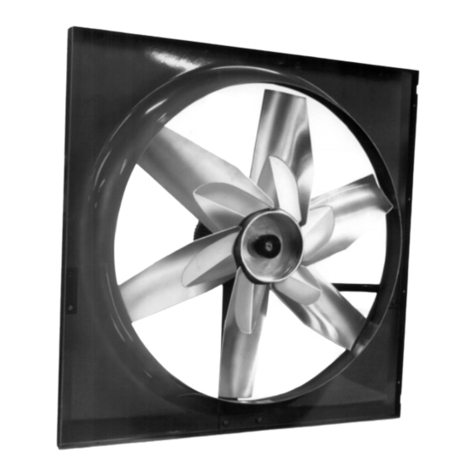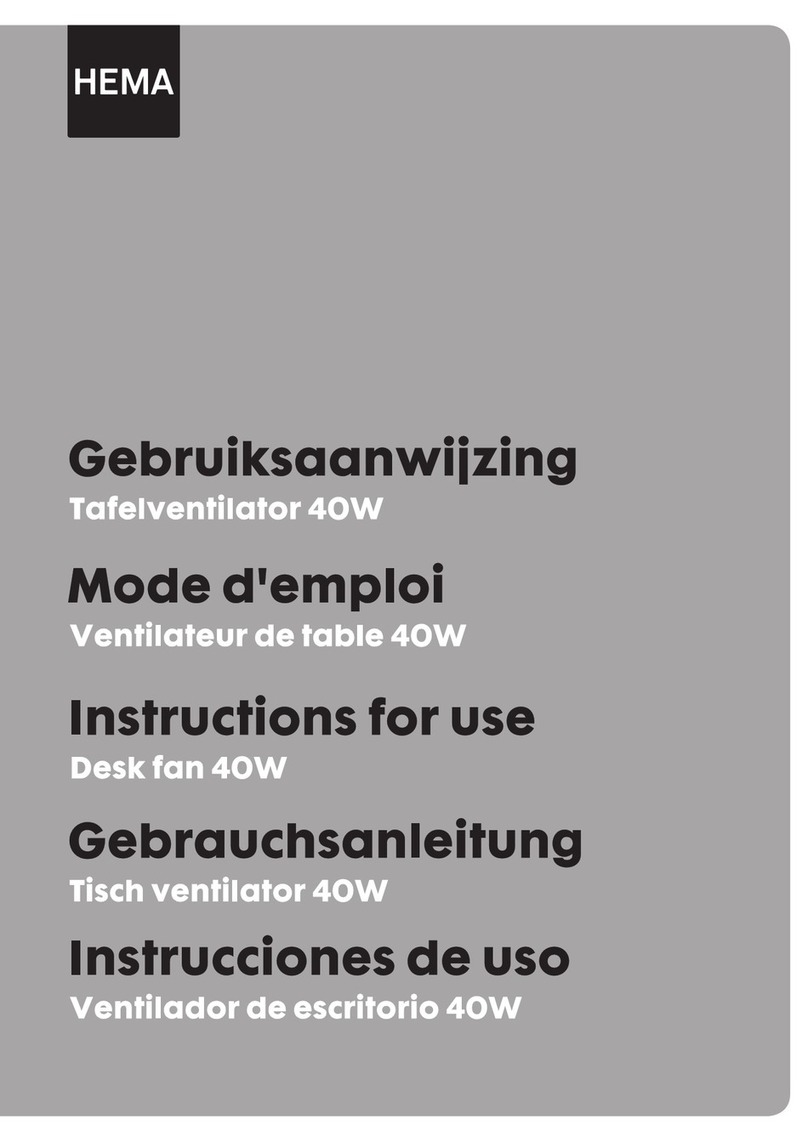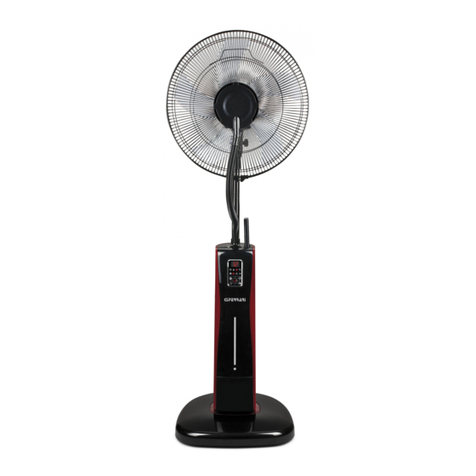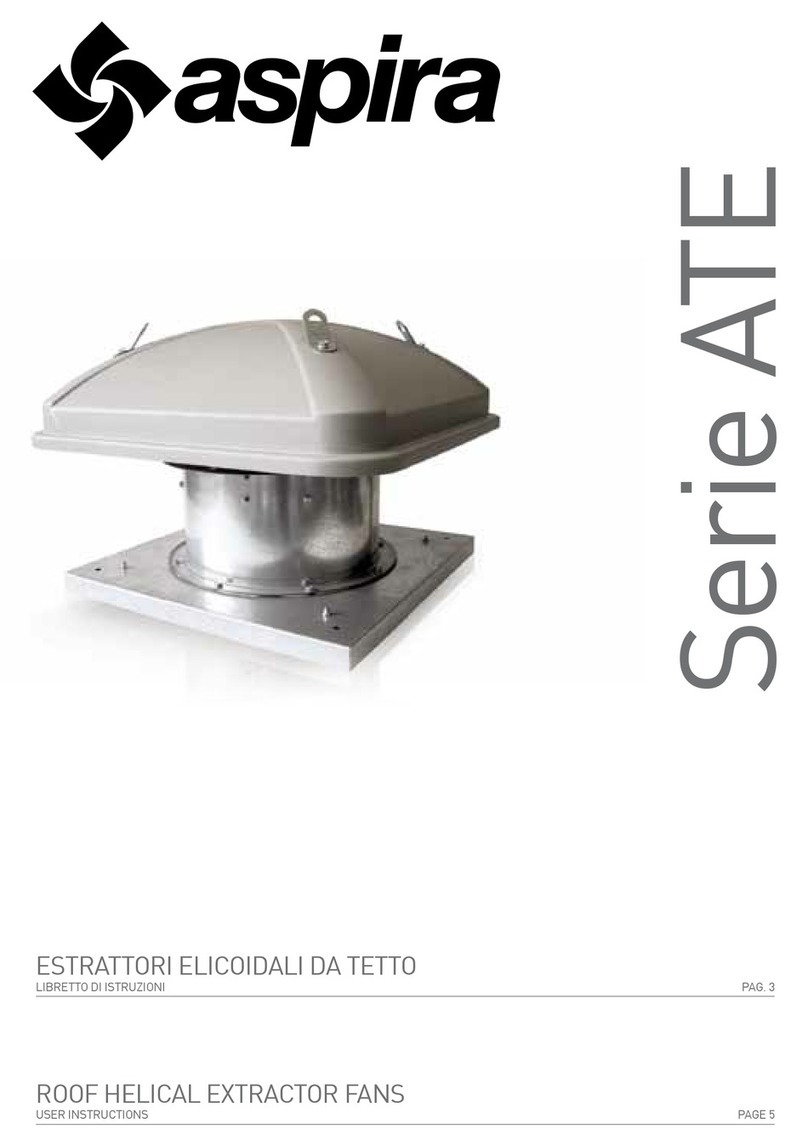SMOG-HOG SH Series User manual

OPERATIONS MANUAL
SH Series Models:
SH-6
SH-10
SH-20
SH-40
SH-50


SH Series Operations Manual
TABLE OF CONTENTS
SECTION DESCRIPTION PAGE
I. INSPECTION OF EQUIPMENT 2
II. INSTALLATION PLANNING 2
Ill. INSTALLATION
A. Unit Mounting 2
B. Metal Truss Supported Ceilings 3
C. Column or Wall Mounting 3
IV. AIR DIFFUSER
A. Unducted Installation 3
B. Ducted Installation 5
V. ELECTRICAL REQUIREMENTS
A. Power Connection on C Models 5
B. Power Connection on PE Models 5
VI. MOTOR/BLOWER CHECKOUT
A. Drive Set Access Procedure 5
VII. DESCRIPTION OF COMPONENTS
A. Prefilters 5
B. Ionizing Sections 5
C. Collection Cells 6
D. Afterfilters 6
E. Power Packs 6
F. Push-to-Test Buttons 6
G. Blower 6
H. Drive 6
I. Outlet Vanes 6
J. Cabinet 6
K. Access Door (Electrostatics) 6
L. Access Door (Drive Set) 6
VIll. MAINTENANCE
A. Cleaning Instructions 6
B. Instructions for Replacing Ionizer Wire 7
IX. TROUBLESHOOTING
A. Troubleshooting Procedures 7
X. ORDERING PARTS 8
XI. APPENDIX
A. SMOG-HOG Parts List 9
B. SH Series Airflow Curves 10
C. Wiring Diagrams 11

SH Series Operations Manual
1

SH Series Operations Manual 2
SMOG-HOG NOMENCLATURE
SMOG-HOG electronic air cleaners are available in a
variety of configurations and sizes. Codes shown below
identify characteristics which might be built into a given
unit. This model number completely identifies the design
and can be found on the unit nameplate. For example, a
model designated SH-10-PE-H could be defined
according to descriptions listed below (see bold):
SH -SMOG-HOG Series
10 -Airflow in 100s of CFM (i.e., 10 ≅1,000 CFM, etc.)
P-Polyphase, external high voltage wiring
C-
Corded (10' power cord) and external high voltage wiring
E-External high voltage wiring (internal power pack)
H-High static pressure blower◊
DP - Dual polarity
XB - Without blower
S-Stacked modules (SH-40/50 only)
T-Te e-shaped unit (SH-40/50 only)
◊Not available on SH-50 models
Models SH-6, SH-10, SH-20, SH-40 & SH-50
This type of SMOG-HOG Industrial Air Cleaner is a
self-contained, two-stage, Penney-type, electrostatic
precipitator complete with fully-interlocked, energy-limiting,
UL recognized power pack, mechanical prefilter, ionizer,
collection cell, afterfilter, blower assembly, indicator lights,
interlock switches and push-to-test buttons. Models
available include:
SH-6-C SH-20-PE
SH-10-C SH-40-PE-T
SH-20-C SH-50-PE-T
SH-6-PE SH-40-PE-S
SH-10-PE SH-50-PE-S
Models SH-10-XB, SH-20-XB, SH-40-S-XB &
SH-50-S-XB
This type of SMOG-HOG Industrial Air Cleaner is a
self-contained, two-stage, Penney-type, electrostatic
precipitator complete with fully-interlocked, energy-limiting
power pack, mechanical prefilter, ionizer, collection cell,
afterfilter, indicator lights, interlock switches and push-to-
test buttons. XB units are designed for use in tandem with
Models SH-10, SH-20, SH-40 and SH-50 or in a ducted
application where a blower is included in the existing
ventilation system. Models available include:
SH-10-PE-XB SH-40-PE-S-XB
SH-20-PE-XB SH-50-PE-S-XB
SH Series Voltages Available
Voltage Phase HZ Voltage Phase HZ
115* 1 60 230* 3 60
115* 1 50 380* 3 50
208* 3 60 460* 3 60
220* 3 50 575* 3 60
* UL listed
I. INSPECTION OF EQUIPMENT
Upon receipt of your SMOG-HOG, check carefully for any
possible shipping damage. Any damage to carton, skid,
etc. may be a warning to you that rough handling has
caused internal damage. Notify your delivery carrier and
enter a claim if any damage is found.
II. INSTALLATION PLANNING
UNDUCTED OR AREA CAPTURE: Consideration must be
given to the placement of the precipitator to maximize
efficiency. The number of units required to clean the air will
depend on the layout of the room and the concentration of
pollutants. Because it is necessary to develop proper
airflow patterns, the placement and number of
precipitators should be as suggested by UAS or your local
SMOG-HOG representative.
DUCTED OR SOURCE CAPTURE: When your
SMOG-HOG is used as a ducted source collector, the
enclosure or pick-up hood design is important for
adequate capture of contaminants. Drive pulleys and
belts have been selected to provide proper airflow at the
design static pressure specified. Pulleys and belts should
not be replaced without first contacting UAS.
Allow at least 36" door swing and access clearance on the
door side of the unit. All models except the SH-6 require
18" clearance from the electrical junction box on top of the
unit to any overhead obstruction to allow adequate
access.
III. INSTALLATION
Carefully remove the unit from the shipping container,
again inspecting for shipping damage. For ease of
installation, open access door and remove the cell, ionizer
and filters from the cabinet.
Ceiling mounted units are suspended by means of 1⁄2"
threaded rods run through weld nuts in the top corners of
the units. (See page 4 for weld nut locations on all but XB
models†.) Additional support should be used for auxiliary
equipment or ductwork.
†NOTE: Weld nuts are not provided on XB units. These
units are to be supported with flat washers and 1⁄2"-13
nuts supplied by the installer.
Reinstall the components removed earlier to facilitate the
mounting of the unit.
Unit Mounting
Models SH-6, SH-10 and SH-20 are designed for
suspended mounting. They can be provided with eyebolts
for chain hanging, but the length of chain should be kept
at a minimum. The preferred method of hanging is with 1⁄2"
threaded rod through the top of the cabinet. If chain
is used, it should be of the welded link type, with a 2,000
lb. test strength or better. “S” hooks used for connections
should be closed. The chain should be hung vertically. If
any angle is introduced, the chain and fasteners should be

SH Series Operations Manual
3
Figure 1
Proper Installation
Figure 2
Ceiling Mounted Unit
NOTE: The SMOG-HOG should not be used for support of
personnel or material. Check with local building
code/structural engineer to ensure proper installation to roof
truss or column.
Metal Truss Supported Ceilings
Figure 2 shows an SH-20 unit suspended from a metal
truss supported ceiling. Customer must take care to
determine that the truss will be sufficient to support the
weight. As shown, angle iron braces are secured between
two steel trusses. Rod length should be kept to a
minimum.
Column or Wall Mounting
Figure 3 shows an SH-50 (T-shaped) unit suspended from
a cantilevered frame from which the 1⁄2" threaded rods are
suspended. Rods are threaded into weld nuts located at
the corners of the blower cabinet. Rod length should be
kept to a minimum.
sized to handle the added tension. Figure 1 shows the
recommended method for suspending the units with chain.
Models SH-40 and SH-50 may be suspended by rod but
are not approved for chain hanging.
On oily applications, rear blower section elevation of unit
should be 1⁄2" higher than the entrance elevation.
IV. AIR DIFFUSER
The four-way adjustable air diffuser grille can be set to any
open position desired.
Unducted Installation (for area capture)
Air diffuser should be set for maximum contaminant
capture and even dispersion of clean air. The pattern
Figure 3
Column Mounted Unit

SH Series Operations Manual 4
Figure 4
DIMENSIONS AND MOUNTING HOLE LOCATIONS
(IN INCHES AND CENTIMETERS)

SH Series Operations Manual
5
Figure 5
Unit Access
should be that suggested by UAS or your local
SMOG-HOG representative.
Ducted Installation (for direct capture)
Air diffuser can be set to any position compatible with
personnel comfort.
V. ELECTRICAL REQUIREMENTS
Power Connection on C Models
The power cord on SH-6-C, SH-10-C and SH-20-C
should be used in connection with a properly sized and
appropriately located 115 VAC grounded outlet
receptacle. No alteration of the power cord should be
attempted nor should extension cords be used.
Power Connection on PE Models
The only electrical connection required is a power source
to the terminal block as shown in the wiring diagram inside
the top electrical junction box. Connect as indicated on the
“Supply Connection Location” label. See unit nameplate
for voltage specifications.
Units are factory wired for the voltage requirement
indicated to UAS by the customer. The electrical box has
no knockouts. Therefore, whatever electrical connectors
are standard in your plant may be used to bring the power
line into the unit.
The power switch for operating the unit and any fused
disconnect switch must be supplied by the customer
and located remotely (not supplied as part of the
SMOG-HOG). UL listed models are supplied by UAS with
a motor starter and remote start/stop pushbutton switch
as standard equipment.
VI. MOTOR/BLOWER CHECKOUT
After three-phase connection is made, check the direction
of rotation of the blower wheel. See Figure 5 for drive set
door access. If the wheel is not rotating in the proper
direction, reverse the motor rotation by interchanging any
two of the three AC input leads at the terminal block.
CAUTION: Even when running backward, some air
motion is noticeable. If the blower is rotating correctly,
the access door will be snapped shut by the strong
negative pressure within the cabinet.
When the SMOG-HOG is used in a ducted application,
blower speed is increased to compensate for the static
pressure loss of the ductwork. After ductwork is installed,
and with the unit operating, measure the current flow to
the unit using an amprobe. The ampere reading should
not exceed the FLA rating stamped on the motor
nameplate. If current flow is excessive, reduce blower
speed by adjustment of the variable pitch sheave on
the motor.
CAUTION: Measure the current at the remote starter
or disconnect. Erroneous readings will result if
measurements are made in the vicinity of the high
voltage power supply located in the electrical box.
Single-phase units (i.e., 115/1/50-60) are prewired for
proper rotation and line hook-up. Simply connect to single-
phase input circuit and unit is ready for operation.
Input to the high voltage power pack must not exceed 120
volts, 60 Hertz. This is supplied by the power line or the
step-down transformer as shown in the wiring diagram
inside the main electrical junction box on all units.
The indicator light on the unit is illuminated when high
voltage is present at the power pack. If the light fails to
illuminate when power is turned on, refer servicing to
authorized personnel.
Drive Set Access Procedure
1. Shut down blower.
2. Remove (1) cell and (1) afterfilter.
3. Reach through ESP compartment for access to
thumbscrew.
4. Rotate captive thumbscrew until blower
compartment door is released.
5. Reverse above operation for closure.
VII. DESCRIPTION OF COMPONENTS
(See page 1 for photos of individual model components)
A. Prefilters. Heavy-duty, reusable aluminum mesh,
industrial service filters aid air distribution and
mechanically remove large particles not suitable for
precipitation. They are interchangeable with afterfilters.
B. Ionizing Sections. Ionizing sections are independent
of collection cells for ease of maintenance. The frame, of
rugged aluminum construction, supports tungsten steel
ionizing wires. Each wire is spring mounted and easily
replaced in the field. Both spring and wire support bars
and heavy ceramic insulators are located out of the
airstream, behind a three-sided aluminum extrusion with
an airfoil design, to further limit insulator contamination.
An extremely dense ionizing field and integral bypass

SH Series Operations Manual 6
prevention baffles assure ionization of all particles
entering the precipitator.
C. Collection Cells. Parallel plate collection components
are of aluminum construction. Air gap insulators which
afford a longer path to ground are located completely out
of the dirty airstream. This arrangement maintains nominal
operating voltages longer, thus reducing the frequency of
cleaning. The insulators, along with the cell’s long plate
design, assure maximum efficiency and retention of
collected contaminant.
D. Afterfilters. Heavy-duty, reusable, industrial
aluminum mesh filters aid even air distribution across the
cells and trap any collected contaminant that might blow
off the cells during start and stop operations. They are
interchangeable with prefilters.
E. Power Packs. The proprietary design high-voltage
power supply sends 11 KV DC to collection components
and is limited to less than .005 amps of current at short
out. This limited current draw will protect both the power
pack and components in a short-out condition. Power
consumption is 75 watts maximum. The power pack is
located in an external electrical box.
F. Push-to-Test Buttons. An exclusive UAS
feature, these buttons verify electrical continuity during
equipment operation without the use of a meter. They are
also a convenient means to ground any residual charge
in components before removing them from a deactivated
unit.
G. Blower. A belt-driven, low speed, centrifugal-type
blower with sealed ball bearings is shock-mounted to the
cabinet to reduce noise and vibration.
H. Drive. Motors are continuous-duty, totally-enclosed
and fastened to adjustable motor mounts. The motor is
equipped with a variable speed motor pulley allowing
blower speed on-site adjustment.
I. Outlet Vanes. Four-way-direction, individually
adjustable deflectors permit adjustment of cleaned air
distribution to meet specific application requirements.
J. Cabinet. This 16-gauge steel housing is of wrap-
around construction with all seams welded. The cabinet is
prepared in a phosphatized wash cycle. The finish coat is
an electrostatically-applied powder paint, baked to ensure
a durable hard finish. The electrostatic compartment
features bypass baffles on the door and rear wall to guide
the contaminated airstream through the components.
K. Access Door (Electrostatics). Doors are hinged for
easy access and interlocked to shut down high-voltage
when opened.
L. Access Door (Drive Set). A separate hinged
door allows access to motor and blower for easy
adjustment (see Figure 5).
VIII. MAINTENANCE
Normal maintenance is confined to periodic cleaning of
cell, ionizer and filters, plus checking of the drive belt.
Rarely is any other maintenance necessary.
Cleaning Instructions
• Turn unit off and depress both push-to-test buttons to
remove any residual charge from components.
• Slide dirty collection components (prefilter, ionizer, cell
and afterfilter) from cabinet.
• Clean components by soaking in a hot solution of
detergent for a minimum of 30 minutes. Shake
components in the hot solution to remove loosened dirt.
Any cleaner used must be inhibited for the protection of
aluminum filters and cells. UAS has specific detergent
recommendations.
• Immediately after removing components from the
detergent bath, flush away any remaining residue and
rinse thoroughly with water. Shake off excess water.
• Set collection cells, ionizers and mesh filters in a warm
room, with plates standing vertically, until they have
completely drained and are dry to the touch. Twenty
minutes is normally satisfactory.
• Wipe off contaminant from the high voltage insulators
located on the back wall of the cabinet.
• Reinstall components in the cabinet, close the door and
turn the unit on. Connecting springs between cell and
ionizer sections must be turned to the center of the
cabinet for double component units (i.e., units with
adjacent removable components — SH-20, SH-40 and
SH-50). Electrical contact must be made between cells
and ionizers by these springs. Make sure wall and door
ground springs are in place and making contact with
ionizer and cell endplates respectively. See Figure 10 for
properly aligned assembly.
Figure 6
Replacing Ionizer Wire

SH Series Operations Manual
7
Figure 7
Checking Ionizer Voltage
Figure 8
Checking Cell Voltage
• Periodically check for loose drive belt on the
motor/blower unit. One-half inch deflection under light
thumb pressure at mid-point between pulleys is the
normal correct tension.
Instructions for Replacing Ionizer Wire
• Remove the damaged wire from each spring. Replace
spring if damaged.
• Loop one end of the new wire over the bottom spring
then extend the top spring and loop the end of the wire
over the spring (see Figure 6). Pliers may aid this
operation.
• Release the spring gently. The wire is now taut and
automatically centered.
NOTE: In the event that replacement wires are not
available, the ionizer may be left in service. Remove
the broken wire(s) and springs from assembly until
replacement is made.
THE FOLLOWING SECTIONS
ARE FOR THE USE OF
TRAINED PERSONNEL ONLY
CAUTION: Hazardous live and
moving parts are exposed during
the following procedures.
IX. TROUBLESHOOTING
Tools Required:
• Screwdriver 8" or longer with plastic handle
• Volt-Ohm-Meter — used to check low voltage input
(115 VAC) and continuity (OHMS)
• High Voltage Probe — used to check high voltage power
supply. Range: from 0 to 15 KV DC
• Amp Probe
Troubleshooting Procedures
High voltage problems can generally be isolated by
referring to the indicator light. When the light illuminates,
high voltage is present at the ionizer and collector
terminals of the power pack.
If the indicator light illuminates but there is no high voltage
present at the ionizer or collector, the difficulty is caused
by an open circuit in the high voltage path. Test for high
voltage is made by depressing push-to-test buttons
individually. This should short out the circuit, causing the
indicator light to go out, thus verifying electrical
continuity.
If light does not go out, check for the presence and
condition of high voltage contact springs, hardware and
(red) high voltage lead wires. See Figure 9 for proper
alignment.
If the indicator light is out, proceed to isolate the difficulty
as follows:
Open the access door and depress the interlock switch.
Check for presence of high voltage at cell and ionizer

SH Series Operations Manual 8
Figure 9
Properly Aligned Assembly
with the high voltage test probe by connecting one
probe lead to ground and the other lead to the (a)
ionizer wire support (Figure 7) and then (b) to the end
of the high voltage cell rod (Figure 8).
If high voltage is present, check that contact leads at
light terminals and ground plate are snug. If contacts
and leads are satisfactory, replace the light. Be sure
that the electrical box lid switch and access door switch
are closed when making the final check.
If the indicator light is out and no voltage is present at the
cell and ionizer, proceed as follows:
Open access door and remove the collection cell(s).
Depress the door interlock switch and observe the
indicator light. If the light illuminates, the collection cell
is shorted. Carefully check for the presence of
excessive dirt build-up or foreign material lodged
between cell plates or bowed cell plates that would
cause the cell to short out.
If the light remains out with the cell removed, close the
door, discharge the high voltage with push-to-test buttons
and remove the ionizer(s). Depress the door switch and
observe the indicator light. If the light illuminates, the
ionizer is shorted. Check for broken ionizer wires and
build-up of contaminant on insulators. Wipe the insulators
clean and replace ionizer wire(s) if necessary.
If the indicator light does not illuminate when components
are removed, proceed as follows:
Secure the component access door and open the
electrical box lid. Depress the lid interlock switch
and check for 115 VAC supply to the power pack. If
115 VAC supply voltage is present, release the lid
interlock and remove one of the (red) high voltage
leads from the power pack terminals. Depress the lid
interlock switch and observe the indicator light. If the
light illuminates, one of the high voltage leads or
contact springs is shorted to ground. Check for proper
electrical alignment of contact springs and for a
defective (red) high voltage lead. Replace if necessary.
If the light remains out, repeat the procedure on the
second (red) high voltage lead. If the indicator light
does not illuminate when both (red) high voltage leads
are removed, replace the power pack.
X. Ordering Parts
To order replacement parts refer to “SMOG-HOG Parts
Lists” on page 9. Order through your local UAS
representative or contact United Air Specialists
4440 Creek Road, Cincinnati, Ohio 45242. Telephone
1-800-252-4647 or Fax 513-891-4171. Please have the
unit model number, serial number (from inside component
access door) and part numbers available when ordering.

SH Series Operations Manual
9
SMOG-HOG PARTS LISTS
COMPONENT DESCRIPTION PART NUMBER
POWER PACK - POSITIVE (UL LISTED) 21-1216
POWER PACK - NEGATIVE (UL LISTED) 21-1220
LIGHT SOCKET (ALL INCANDESCENT TYPE LIGHTS)* 20-0258
RED LENS* 20-0260
CLEAR LENS* 20-0133
6 V BULB - INCANDESCENT, #47 LIGHT* 20-0467
GREEN 12 V DC LED INDICATOR LIGHT, 10mm (GREEN BODY) 20-2748
GREEN 12 V DC LED INDICATOR LIGHT, 17mm (W/WIRE LEADS) 02-10561-G
100 V.A. STEP-DOWN TRANSFORMER (208 to 115V) 21-1279-100
(FOR SH-6, SH-10 & SH-20) (230V or 460V to 115V) 21-1280-100
(575V to 115V) 21-1281-100
150 V.A. STEP-DOWN TRANSFORMER (208 to 115V) 21-1279-150
(FOR SH-20, SH-40 & SH-50) (230V or 460V to 115V) 21-1280-150
(575V to 115V) 21-1281-150
250 V.A. STEP-DOWN TRANSFORMER (208 to 115V) 21-1279-250
(FOR SH-40 & SH-50) (230V or 460V to 115V) 21-1280-250
(575V to 115V) 21-1281-250
LIMIT SWITCH, CABINET DOOR INTERLOCK 20-0005
LIMIT SWITCH, ENCLOSURE INTERLOCK (SWITCH BRACKET: 20-1243) 20-1239
GPN CELL ASSEMBLY (ALL UNITS EXCEPT SH-6) 02-2339-S
SH-6 CELL ASSEMBLY 02-0003-S
CELL-TO-CELL CONTACT SPRING 36-0009
CELL INSULATOR - HORSESHOE 37-0007
CELL INSULATOR - TRIANGLE (AFTER JULY 1988) 37-0061
FP IONIZER ASSEMBLY - 9 WIRE (ALL UNITS EXCEPT SH-6) 02-0044-S
SH-6 IONIZER 02-0008-S
IONIZER STAND-OFF INSULATOR 37-0004
IONIZER-TO-IONIZER CONTACT SPRING 36-0016
IONIZER WIRES, 6/SET (1 0 MIL) - (SH-6) 03-0834
IONIZER WIRES, 9/SET (10 MIL) - (SH-10, SH-20, SH-40 & SH-50) 03-0555
IONIZER WIRE SPRINGS, 20/SET 03-0559
PRE/AFTERFILTER - ALUMINUM MESH (ALL UNITS EXCEPT SH-6) 33-0001
SH-6 PRE/AFTERFILTER 33-0098
INSULATOR ASSEMBLY (CELL-TO-CABINET FEED-THRU) 02-0748
INSULATOR ASSEMBLY (IONIZER-TO-CABINET FEED-THRU) 02-0747
INSULATOR (CELL/CABINET INTERNALLY WIRED UNITS) 37-0012
INSULATOR (IONIZER/CABINET INTERNALLY WIRED UNITS) 37-0013
CONTACT SPRING, IONIZER- AND CELL-TO-CABINET OR -DOOR 36-0014
GROUND SPRING 36-0077
TRUSS HEAD SCREW 30-0082
ACORN NUT 30-0223
*UNITS WITH 6V INCANDESCENT LIGHTS

SH Series Operations Manual 10
SH SERIES
AIRFLOW CURVES

SH Series Operations Manual
11


UNITED AIR SPECIALISTS, INC.
LIMITED WARRANTY
UAS warrants all equipment manufactured and sold by UAS against defective parts and
workmanship for one year from date of shipment to Purchaser. This warranty is subject
to the limitations in UAS’ standard terms and conditions provided to Purchaser. Any
unauthorized repairs or modifications or abnormal use or misuse of equipment will void
all warranties. In no case will UAS’ responsibility or warranty extend to equipment not
manufactured by UAS.
THE FOREGOING WARRANTY IS EXCLUSIVE AND IN LIEU OF ALL OTHER WARRANTIES,
WHETHER WRITTEN, ORAL OR IMPLIED, INCLUDING ANY IMPLIED WARRANTY OF
MERCHANTABILITY, FITNESS FOR A PARTICULAR PURPOSE OR NONINFRINGEMENT.
As Purchaser’s exclusive remedy for any defects in the equipment, UAS will exchange or
repair any defective parts during the warranty period, provided such parts are returned,
prepaid, to UAS’ factory. The obligation of UAS is limited to furnishing replacement parts
F.O.B. UAS’ factory or making repairs at UAS’ factory of any parts which are determined,
upon inspection by UAS, to be defective. UAS is not responsible for labor or
transportation charges for the removal, reshipment or reinstallation of the parts.
IN NO EVENT WILL UAS BE RESPONSIBLE FOR ANY SPECIAL OR CONSEQUENTIAL DAMAGES.
4440 Creek Road • Cincinnati, Ohio 45242 USA
National Phone: (800) 252-4647
Telephone: (513) 891-0400 • Fax: (513) 891-4882
http://www.uasinc.com
An ISO 9001 Certified Company
ISO 4.1.17 4/02
© 1999 United Air Specialists, Inc.
PART NO. 44-0150
United Air Specialists, Inc. reserves the right to
change design or specifications without notice.
This manual suits for next models
19
Table of contents
